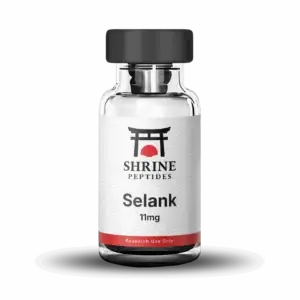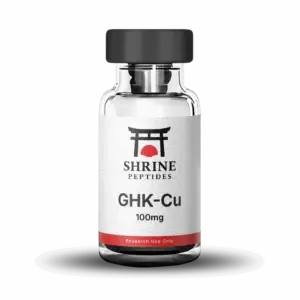GHK-Cu (50mg)
$51.00
GHK-Cu (50mg) – Research grade peptide for laboratory investigations and preclinical studies | Research Use Only – Not for Human Consumption
GHK-Cu (50mg) Research Compound
Research Use Only – Not for Human or Animal Consumption
GHK-Cu (50mg) is a synthetic research peptide that has been investigated in laboratory settings for its potential interactions with various biological pathways. This research compound has been studied in preclinical models to evaluate its pharmacological properties and potential mechanisms of action.1 Preliminary investigations have examined this peptide’s effects on cellular signaling pathways, receptor interactions, and physiological responses in controlled laboratory environments.
Research Overview
Laboratory studies have explored the potential biological activities of GHK-Cu (50mg) through various experimental methodologies. Research has focused on characterizing the peptide’s structure-activity relationships, binding affinities to target receptors, and downstream signaling cascade activation.2 Preclinical investigations have utilized multiple research models to assess the compound’s pharmacokinetic properties, including absorption, distribution, metabolism, and elimination characteristics. These fundamental research efforts contribute to the broader understanding of peptide-based signaling mechanisms and their potential applications in biological research.
Preclinical Investigations
Research teams have conducted systematic investigations to evaluate GHK-Cu (50mg)’s biological activities in controlled experimental settings. Studies have employed various in vitro and in vivo methodologies to assess the peptide’s effects on cellular processes, tissue function, and systemic responses in research models.3 Data from these investigations have contributed to understanding the peptide’s potential mechanisms of action, optimal dosing parameters for research applications, and potential interactions with biological systems.
Product Specifications
- Contents: GHK-Cu (50mg)
- Form: Lyophilized powder
- Purity: >98% (verified by HPLC)
- Storage: Store at -20°C in a dry environment
- Reconstitution: Use bacteriostatic water for laboratory applications
- Stability: Stable when stored properly under recommended conditions
Quality Assurance and Documentation
- Third-party laboratory tested for purity and identity verification
- Certificate of Analysis (COA) available upon request for each batch
- HPLC chromatography results provided
- Mass spectrometry data available
- Manufactured under strict quality control protocols
- Batch-specific documentation and traceability
- Compliance with research-grade standards
Research Applications
- Peptide receptor interaction studies
- Cellular signaling pathway research
- Pharmacokinetic and pharmacodynamic investigations
- Structure-activity relationship studies
- Preclinical model research
- Biochemical pathway mapping
- Molecular mechanism elucidation
- In vitro biological activity screening
- Peptide stability and formulation research
- Comparative peptide pharmacology studies
Important Research Notice
FOR LABORATORY AND RESEARCH USE ONLY. This product is intended exclusively for scientific research, in vitro studies, and laboratory investigations. This compound is not intended for human or animal consumption, clinical applications, or any diagnostic or therapeutic uses.
Researchers should consult relevant scientific literature and follow appropriate safety protocols when handling this research compound. Proper laboratory equipment, personal protective equipment, and training are required for working with this material.
Regulatory Compliance Statement
This product is sold as a research chemical for laboratory use only. Shrine Peptides operates as a chemical supplier. Shrine Peptides is not a compounding pharmacy or chemical compounding facility as defined under 503A of the Federal Food, Drug, and Cosmetic Act. Shrine Peptides is not an outsourcing facility as defined under 503B of the Federal Food, Drug, and Cosmetic Act.
The statements made within this product description have not been evaluated by the US Food and Drug Administration. The products we offer are not intended to diagnose, treat, cure or prevent any disease. Human/Animal Consumption Prohibited. Laboratory/In-Vitro Experimental Use Only.
Please review and adhere to our Terms and Conditions before ordering.
References:
- Pickart, Loren, and Anna Margolina. “Regenerative and Protective Actions of the GHK-Cu Peptide in the Light of the New Gene Data.” International journal of molecular sciences vol. 19,7 1987. 7 Jul. 2018, doi:10.3390/ijms19071987. https://www.ncbi.nlm.nih.gov/pmc/articles/PMC6073405/
- Pickart L, Freedman JH, Loker WJ, Peisach J, Perkins CM, Stenkamp RE, Weinstein B. Growth-modulating plasma tripeptide may function by facilitating copper uptake into cells. Nature. 1980 Dec 25;288(5792):715-7. doi: 10.1038/288715a0. PMID: 7453802. https://pubmed.ncbi.nlm.nih.gov/7453802/
- L.O. Pilgeram, L.R. Pickart, Control of fibrinogen biosynthesis: The role of free fatty acid, Journal of Atherosclerosis Research, Volume 8, Issue 1, 1968, Pages 155-166, ISSN 0368-1319, https://doi.org/10.1016/S0368-1319(68)80089-4
- Pickart L, Freedman JH, Loker WJ, Peisach J, Perkins CM, Stenkamp RE, Weinstein B. Growth-modulating plasma tripeptide may function by facilitating copper uptake into cells. Nature. 1980 Dec 25;288(5792):715-7. doi: 10.1038/288715a0. PMID: 7453802. https://pubmed.ncbi.nlm.nih.gov/7453802/
- Pickart L, Vasquez-Soltero JM, Margolina A. GHK and DNA: resetting the human genome to health. Biomed Res Int. 2014;2014:151479. doi: 10.1155/2014/151479. Epub 2014 Sep 11. PMID: 25302294; PMCID: PMC4180391. https://pubmed.ncbi.nlm.nih.gov/25302294/
- Maquart FX, Pickart L, Laurent M, Gillery P, Monboisse JC, Borel JP. Stimulation of collagen synthesis in fibroblast cultures by the tripeptide-copper complex glycyl-L-histidyl-L-lysine-Cu2+. FEBS Lett. 1988 Oct 10;238(2):343-6. doi: 10.1016/0014-5793(88)80509-x. PMID: 3169264. https://pubmed.ncbi.nlm.nih.gov/3169264/
- Siméon A, Emonard H, Hornebeck W, Maquart FX. The tripeptide-copper complex glycyl-L-histidyl-L-lysine-Cu2+ stimulates matrix metalloproteinase-2 expression by fibroblast cultures. Life Sci. 2000 Sep 22;67(18):2257-65. doi: 10.1016/s0024-3205(00)00803-1. PMID: 11045606. https://pubmed.ncbi.nlm.nih.gov/11045606/
- Cangul IT, Gul NY, Topal A, Yilmaz R. Evaluation of the effects of tripeptide-copper complex and zinc oxide on open-wound healing in rabbits. Vet Dermatol. 2006 Dec;17(6):417-23. doi: 10.1111/j.1365-3164.2006.00551.x. PMID: 17083573. https://pubmed.ncbi.nlm.nih.gov/17083573/
- Gul NY, Topal A, Cangul IT, Yanik K. The effects of tripeptide copper complex and helium-neon laser on wound healing in rabbits. Vet Dermatol. 2008 Feb;19(1):7-14. doi: 10.1111/j.1365-3164.2007.00647.x. PMID: 18177285. https://pubmed.ncbi.nlm.nih.gov/18177285/
- Mulder GD, Patt LM, Sanders L, Rosenstock J, Altman MI, Hanley ME, Duncan GW. Enhanced healing of ulcers in patients with diabetes by treatment with glycyl-l-histidyl-l-lysine copper. Wound Repair Regen. 1994 Oct;2(4):259-69. doi: 10.1046/j.1524-475X.1994.20406.x. PMID: 17147644. https://pubmed.ncbi.nlm.nih.gov/17147644/
- Bobyntsev II, Chernysheva OI, Dolgintsev ME, Smakhtin MY, Belykh AE. Anxiolytic effects of Gly-His-Lys peptide and its analogs. Bull Exp Biol Med. 2015 Apr;158(6):726-8. doi: 10.1007/s10517-015-2847-3. Epub 2015 Apr 23. PMID: 25900608. https://pubmed.ncbi.nlm.nih.gov/25900608/
- Sever’yanova LА, Dolgintsev ME. Effects of Tripeptide Gly-His-Lys in Pain-Induced Aggressive-Defensive Behavior in Rats. Bull Exp Biol Med. 2017 Dec;164(2):140-143. doi: 10.1007/s10517-017-3943-3. Epub 2017 Nov 27. PMID: 29181666. https://pubmed.ncbi.nlm.nih.gov/29181666/
- Sakuma, S., Ishimura, M., Yuba, Y., Itoh, Y., & Fujimoto, Y. (2018). The peptide glycyl-ʟ-histidyl-ʟ-lysine is an endogenous antioxidant in living organisms, possibly by diminishing hydroxyl and peroxyl radicals. International journal of physiology, pathophysiology and pharmacology, 10(3), 132–138.
- Zhang, Q., Yan, L., Lu, J., & Zhou, X. (2022). Glycyl-L-histidyl-L-lysine-Cu2+ attenuates cigarette smoke-induced pulmonary emphysema and inflammation by reducing oxidative stress pathway. Frontiers in molecular biosciences, 9, 925700. https://doi.org/10.3389/fmolb.2022.925700
- Miller, D. M., DeSilva, D., Pickart, L., & Aust, S. D. (1990). Effects of glycyl-histidyl-lysyl chelated Cu(II) on ferritin dependent lipid peroxidation. Advances in experimental medicine and biology, 264, 79–84. https://doi.org/10.1007/978-1-4684-5730-8_11








Reviews
There are no reviews yet.